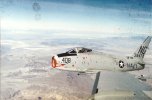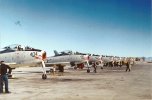For example, why does the Prowler have a rep as being difficult to get aboard? The merits of DLC in carrier aircraft, etc...
Short answer: it flies weird.
Long answer: they added a plug into the A-6 fuselage forward of the wing line, and the Prowler is borderline neutrally longitudinally stable in the landing configuration. For any given trim setting, it's happy anywhere in about a 15-20 knot speed band. So when you adjust power, the nose will not necessarily seek on-speed AOA like a Goosehawk. Also, when you adjust power, the engines' thrust axis is below the CG/CP. So perversely, power on drives AOA slightly slower and power off slightly faster. So couple with the above, you have to lead power changes with slight pitch inputs.
The Prowler does not have ailerons. It has what we call "flaperons," which are technically spoilerons. They kill lift on one wing without adding it on the other; you're not actually rotating around the longitudinal axis in roll. So lineup corrections not led with power will drive you low. Also, in order to put the hook point in the right spot, on-speed AOA is just on the backside of the power curve. Woe betide the guy who gets slow!
The old analog AFCS was not the best at yaw damping, so there were some sketchy dutch roll issues with lineup as well. I never piloted a DFCS jet, so RLSO or someone will have to comment on that.
Finally, the instrument panel sucks. It's too high. As a single anchor type, I had to run my seat all the way up to see the ball. As ECMO 1, who is slightly lower and further back in the cockpit, it's like being in a damned cave. I had to physically lift myself out of the seat to backup my pilot.
Oh, and the obvious answer: "502, Prowler Ball, 6.9, no HUD!"
Edit upon drinking morning coffee: You mentioned DLC. While the Prowler doesn't have DLC per se, the old AFCS would let you cheat by quickly wiggling the stick back and forth in close to at the ramp. This would not appreciably roll the jet, but would act like DLC. Do this with DFCS, and all it will let you do is waggle the wings and annoy everyone else in the jet with you.
Also, the steam gauge cockpit is a different scan. I was a HUD-crippled C guy who couldn't make the adjustment, and part of it is that it's a significantly different scan technique going from two MFDs to an old-style cockpit.

 .
.


